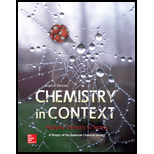
(a)
Interpretation:
What is an ion has to be found and two examples have to be given.
Concept Introduction:
Ionizing radiation:
Ionizing radiation carries energetic electrons from atoms or molecules and thus converts those atoms and molecules as ions. Apart from electrons, ionizing radiation is made up of other energetic sub-atomic particles, ions or atoms that are moving at high-speeds.
(b)
Interpretation:
The examples for species having unpaired electrons have to be given.
Concept Introduction:
Generation of free-radicals:
The free radicals are usually initiated by homolytic fission which is the
Example:

(c)
Interpretation:
How do radiation produces ions with unpaired electrons has to be explained.
Concept Introduction:
Ionizing radiation:
Ionizing radiation carries energetic electrons from atoms or molecules and thus converts those atoms and molecules as ions. Apart from electrons, ionizing radiation is made up of other energetic sub-atomic particles, ions or atoms that are moving at high-speeds.
Free radicals: Free radicals are fragments that are resulted from homolytic cleavage of a chemical bond and thus hold an unshared electron which is always represented by a dot. These species are highly unstable species and thus being highly reactive species.
(d)
Interpretation:
How free radicals cause random mutation in DNA has to be explained.
Concept Introduction:
Ionizing radiation:
Ionizing radiation carries energetic electrons from atoms or molecules and thus converts those atoms and molecules as ions. Apart from electrons, ionizing radiation is made up of other energetic sub-atomic particles, ions or atoms that are moving at high-speeds.
- • The advantage of using ionizing radiation:
Under controlled circumstances, the use of selective ionizing radiation targets to promote the death of cancerous cells.
- • The disadvantage of using ionizing radiation:
The treatment of ionizing radiation involves the risk of causing damage to DNA and reproductive cells.
DNA:
DNA is a self-replicating genetic material that is present in all living organisms. It carries genetic information from one generation to the several successive generations. Basically it is a biopolymer of
Want to see the full answer?
Check out a sample textbook solution
Chapter 12 Solutions
Chemistry in Context
- 1- Refer to the monosaccharides below to answer each of the following question(s): CH₂OH CHO CH₂OH CH₂OH 0 H- OH 0 0 HO- H H- -OH HO H HO H H OH HO- H CH₂OH H. OH HO H HO- H CH₂OH CH₂OH CH3 a. Sorbose b. Rhamnose c. Erythrulose d. Xylulose Classify each sugar by type; for example, glucose is an aldohexose. a. Xylulose is .. b. Erythrulose is . c. Sorbose is .. d. Rhamnose is .. 2- Consider the reaction below to answer the following question(s). CHO H OH CH₂OH CH₂OH HO- H HO HO + H. -OH HO OH HO. H OH OH H -OH H OH CH₂OH Q Z a. Refer to Exhibit 25-11. Place a triangle around the anomeric carbon in compound Q. Compound Z is: b. 1. the D-anomer. 2. the a-anomer. 3. the ẞ-anomer. 4. the L-anomer. c. Which anomer is the LEAST stable? d. Q and Z are cyclic examples of: a. acetals b. hemiacetals c. alditols d. hemialditolsarrow_forwardi need help identifying the four carbon oxygen bonds in the following:arrow_forwardImagine each of the molecules shown below was found in an aqueous solution. Can you tell whether the solution is acidic, basic, or neutral? molecule HO H3N + The solution is... X O acidic OH O basic H3N-CH-C-O O neutral ○ (unknown) O acidic ○ basic CH2 CH 3-S-CH2 O neutral ○ (unknown) H3N O OH O acidic O basic Oneutral O (unknown) 0 H3N-CH-C-O CH3 CH CH3 O acidic O basic O neutral ○ (unknown) ? olo Ar BHarrow_forward
- no ai walkthrougharrow_forwardI have a 2 mil plastic film that degrades after 22 days at 88C and at 61C takes 153 days. What is the failure at 47C in days.arrow_forwardIf a 5 film plastic film degraded in 30 days at 35C and the same film degraded in 10 days at 55 C and 2 days at 65C what would the predicted life time be at 22C for the same film?arrow_forward
- no Ai walkthroughsarrow_forwardI have a aqueous solution (175 ml) of iridium trichloride containing 8,750 ppm Iridium by ICP OES analysis. What is the percent concentration of Iridium trichloride in aquous solution and provide the concentration in moles per liter, percentage by weight.arrow_forwardno Ai walkthroughsarrow_forward
- Chemistry: Matter and ChangeChemistryISBN:9780078746376Author:Dinah Zike, Laurel Dingrando, Nicholas Hainen, Cheryl WistromPublisher:Glencoe/McGraw-Hill School Pub Co
 Chemistry for Today: General, Organic, and Bioche...ChemistryISBN:9781305960060Author:Spencer L. Seager, Michael R. Slabaugh, Maren S. HansenPublisher:Cengage Learning
Chemistry for Today: General, Organic, and Bioche...ChemistryISBN:9781305960060Author:Spencer L. Seager, Michael R. Slabaugh, Maren S. HansenPublisher:Cengage Learning 

 Introductory Chemistry: An Active Learning Approa...ChemistryISBN:9781305079250Author:Mark S. Cracolice, Ed PetersPublisher:Cengage Learning
Introductory Chemistry: An Active Learning Approa...ChemistryISBN:9781305079250Author:Mark S. Cracolice, Ed PetersPublisher:Cengage Learning





